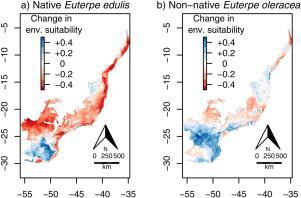Perspectives in Ecology and Conservation ( IF 4.0 ) Pub Date : 2021-03-04 , DOI: 10.1016/j.pecon.2021.02.003 Aline Cavalcante de Souza , Jayme Augusto Prevedello

|
Climate change and biological invasion are major threats to biodiversity, but their combined effects have rarely been quantified. The introduction of congeneric non-native species, in particular, can be especially problematic for native species due to competition and hybridization. Here, we quantify the impacts of climate change on the distribution of an ecologically and economically important native species, Euterpe edulis, and on the invasion potential of its congeneric E. oleracea, across the Atlantic Forest biodiversity hotspot. We modelled current and future environmental suitability for both species, using a comprehensive set of algorithms and climatic scenarios, and quantified the extent of overlap of their environmentally suitable areas. Climate change reduced environmental suitability for E. edulis, but had neutral effects on E. oleracea. Current and future overlap areas, where competition and hybridization are more likely, were concentrated mostly in the southeastern region of Brazil. Our results suggest that native and non-native congeneric species respond differently to climate change, and that climate change and the introduction of E. oleracea are additional threats to the threatened E. edulis. We recommend avoiding new introductions of E. oleracea especially in the southeastern portion of the Atlantic Forest, and the maintenance of protected areas especially in the southern region.
中文翻译:

气候变化和生物入侵是对棕榈树的进一步威胁
气候变化和生物入侵是对生物多样性的主要威胁,但其综合影响很少被量化。特别是,由于竞争和杂交,引入同质非本地物种对于本地物种可能尤其成问题。在这里,我们量化了气候变化对生态和经济上重要的本地物种Euterpe edulis的分布及其同类E. oleracea入侵潜力的影响。,横跨大西洋森林生物多样性热点。我们使用一套全面的算法和气候情景对两种物种的当前和未来环境适应性进行了建模,并量化了其环境适宜区域的重叠程度。气候变化降低了对食用大肠杆菌的环境适应性,但对食用大肠杆菌具有中性影响。当前和将来的重叠区域,其中竞争和杂交的可能性更大,这些区域主要集中在巴西的东南部地区。我们的结果表明,本地和非本地同属物种对气候变化的反应不同,而气候变化和大肠埃希菌的引入是对受威胁的大肠埃希氏菌的另外威胁。。我们建议避免特别是在大西洋森林的东南部引入新的E. oleracea,并避免维护保护区,尤其是在南部地区。











































 京公网安备 11010802027423号
京公网安备 11010802027423号